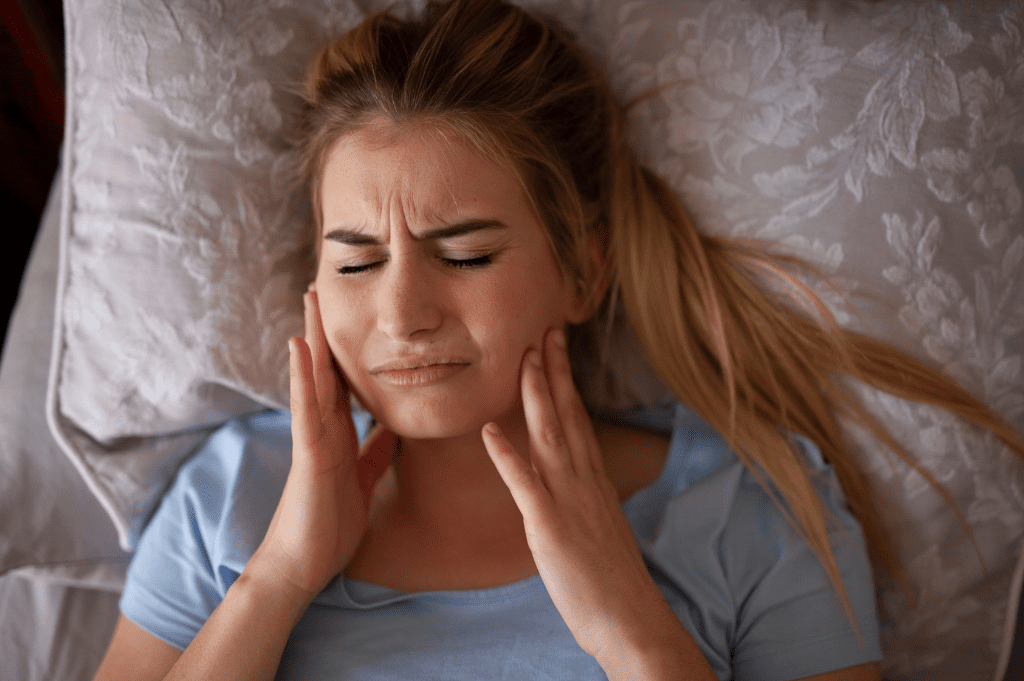If you’ve ever felt a clicking or popping sensation in your jaw while eating or have suffered from jaw soreness, chances are it was caused by a TMJ disorder. A temporomandibular joint disorder or TMJ is a term used to describe a group of symptoms including headaches, facial pain, jaw pain, soreness, clicking or popping in the jaw, and limited jaw movement. In many cases, people suffering from TMJ/TMD report chronic pain in the jaw, teeth, face, head, neck, shoulders, back, or any combination of these areas. Snoring, grinding of teeth, frequent ear infections and restricted airways are other problems associated with TMJ/TMD. It is an extremely common issue but what can dentists do to improve your TMJ disorder? In this blog, I will go over what TMJ disorders are and what dentists can do to help improve them.
What is a temporomandibular joint disorder?
The majority of people suffer to a greater or lesser degree from TMJ. Although women report more pain from TMJ, TMJ in men causes as much or more damage to the teeth, gums, bones and joints. Children are especially sensitive to TMJ and usually show early signs with ear infections, leaning their head on an arm, lip, cheek, or finger biting, sucking or chewing, headaches, snoring, grinding of their teeth at night, and significant chewing of gum.
TMJ stands for “temporomandibular joint,” or jaw joint. These are the small joints in front of each ear that attach the lower jaw to the skull and happen to be the most complex joints in the entire body. The area of the face where the TMJ is located is an intricate network of bones, including the teeth, muscles, and nerves. Because of this, TMJ dysfunctions affect many areas of the body, from the top of the head in migraine-like headaches to numbness or tingling in the arms and pain in the neck or shoulders.
In most cases, TMJ disorders stem from malocclusion, which means having a “bad bite”. Malocclusion means that your upper and lower teeth do not close together in the correct way—they are often misaligned as the result of accidents and trauma. This includes underbites and overbites. When the teeth are misaligned, they cannot provide support to the muscles in the face needed for chewing and swallowing. These muscles are then forced into a strained position, resulting in pain throughout the face, head, arms, shoulders, and back. Although a person may have beautiful teeth or had orthodontics to line the teeth up for aesthetic reasons, the muscles and joints may not be comfortable.
What can dentists do to help alleviate TMJ dysfunction?
Because TMJ dysfunction is so common, everyone should be screened by their dental practitioner for the disorder. Treatment can be as simple as doing things at home to alleviate discomfort to having surgery done for the more extreme cases.
Here are a few things you can do to treat TMJ disorders:
- Apply hot or cold packs: Apply an ice pack to the side of your face just below the ear and temple area for about 10 minutes.
- Do a few simple stretching exercises for your jaw: You can find these online or ask your healthcare provider for suggestions. Apply a hot compress for 5-10 mins.
- Eat softer foods: Your jaw ends up working overtime and can become very stressed the harder the food is you eat. Consider eating softer foods such as yogurt, bananas, fish, mashed potatoes, etc if you are having a bad TMJ flare-up.
- Stop chewing gum: The more you chew for unnecessary reasons, the worse your TMJ disorder can get. If you want to freshen your breath, consider using tic tacs or mints that don’t require chewing.
- Over-the-counter nonsteroidal anti-inflammatory drugs (NSAIDs): Many over-the-counter drugs can help alleviate soreness and pain stemming from your TMJ disorder such as aspirin, and ibuprofen (Advil®, Motrin®) or naproxen (Aleve®). If this is still not working, consider asking your registered healthcare provider for something stronger.
- Wear an orthotic mouthpiece: Often for this step, a temporary device, known as an orthotic is worn over the teeth. The orthotic allows your neuromuscular dentist to make easy adjustments to the plastic without adjusting the teeth until the bite is stabilized. Once symptoms are relieved and the bite has been stabilized, your dentist will move on to the next step and permanently adjust your bite to the correct position.
- Undergo corrective dental treatments:
- Coronoplasty/Equilibration: Coronoplasty is smoothing and reshaping the enamel of the teeth to correct your bite. It is a simple procedure that does not require anesthesia and can be used when the bite is only slightly misaligned.
- Removable Overlay Partials: These are permanent orthotics that usually fit over the back teeth and are designed to maintain an aligned bite.
- Reconstruction: This approach involves making the teeth higher by using crowns. This permanently realigns the bite and provides structural support for the jaw.
- Braces: When the teeth are healthy they may be moved to the optimal position using braces.
Next Steps
Overall, there are many different treatment options to fix TMJ disorders. It all comes down to visiting your local dentist or orthodontist to go over what issues you are having and creating a customized treatment plan that will work best for you. Dr. Salyani at Collingwood Dentistry specializes in treating patients with TMJ disorders and has been doing so successfully for a number of years. If you are curious, give the office a call at (705) 293-7700 and book an appointment.

